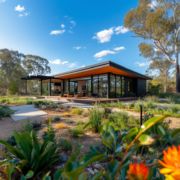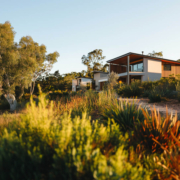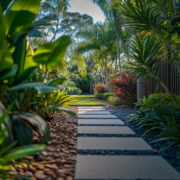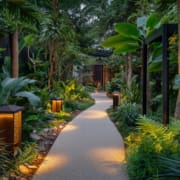How to Design a Low-Maintenance Garden in Brisbane
Creating a low-maintenance garden doesn’t mean sacrificing beauty or functionality. In Brisbane’s subtropical climate, with its hot summers and mild winters, choosing the right design elements and plants can simplify garden upkeep while still providing a lush and appealing outdoor space. This guide will walk you through the essential steps for designing a low-maintenance garden that thrives in Brisbane’s unique conditions.
1. Understand Brisbane’s Climate and Soil
The first step in designing a low-maintenance garden is understanding the local climate and soil conditions.
Subtropical Climate
- Temperature Considerations: Brisbane’s warm, humid summers and mild winters necessitate the selection of heat-tolerant plants that can withstand high temperatures and humidity.
- Rainfall Patterns: With significant rainfall, it’s crucial to choose plants and design elements that can handle both wet and dry conditions without requiring constant intervention.
Soil Conditions
- Soil Types: Brisbane’s soils range from sandy to clayey. Conducting a soil test helps you understand its composition and pH, allowing for appropriate soil amendments.
- Soil Improvement: Incorporate organic matter such as compost to improve soil structure, drainage, and fertility, which can reduce the need for frequent fertilisation and watering.
2. Choose Low-Maintenance Plants
Selecting the right plants is key to reducing garden upkeep. Opt for varieties that are hardy, resilient, and suited to Brisbane’s climate.
Native Plants
- Drought-Tolerant Natives: Native plants such as Grevillea, Callistemon, and Banksia are well-adapted to Brisbane’s conditions and generally require less water and maintenance.
- Low Water Needs: Many native plants have low water requirements once established, reducing the need for frequent irrigation.
Hardy Perennials
- Resilient Varieties: Choose hardy perennials like Liriope, Daylilies, and Lomandra that can withstand varying weather conditions and require minimal care.
- Evergreen Plants: Incorporate evergreen plants such as Clivea and Rhoeo for year-round greenery with less need for pruning and replanting.
3. Incorporate Mulching and Ground Covers
Using mulch and ground covers can significantly reduce maintenance by suppressing weeds, retaining soil moisture, and improving soil health.
Types of Mulch
- Organic Mulch: Use organic mulches like wood chips, bark, or straw to enrich the soil as they decompose and provide a natural look to your garden.
- Inorganic Mulch: For a more permanent solution, consider inorganic mulches such as gravel or rubber. These materials do not decompose and require less frequent replacement.
Ground Covers
- Low-Growing Plants: Ground covers like Blue Star Creeper, Thyme, or Carpet Bugleweed can cover large areas, reduce weed growth, and minimise the need for frequent maintenance.
- Spreading Varieties: Opt for spreading varieties that quickly establish and cover bare soil, providing a dense ground cover that suppresses weeds.
4. Implement Efficient Irrigation Systems
An efficient irrigation system can help manage water usage and reduce the time spent on manual watering.
Drip Irrigation
- Targeted Watering: Install a drip irrigation system to deliver water directly to the plant roots. This method minimises water wastage and ensures that plants receive consistent moisture.
- Automated Timers: Use automated timers to schedule watering times and durations, reducing the need for manual adjustments and ensuring efficient water use.
Rainwater Harvesting
- Rain Barrels: Collect and store rainwater using barrels or tanks. This water can be used for irrigation, helping to reduce reliance on municipal water supplies.
- Gutter Systems: Install a gutter system to direct rainwater into storage tanks or barrels, maximising the use of natural rainfall for garden irrigation.
5. Design with Low-Maintenance Hardscaping
Incorporating hardscaping elements can complement your garden design and reduce the amount of plant maintenance required.
Paved Areas
- Patios and Pathways: Use durable paving materials such as concrete, natural stone, or bricks for patios and pathways. These surfaces are easy to maintain and can handle foot traffic without requiring frequent repairs.
- Outdoor Living Spaces: Create outdoor living areas with low-maintenance materials for furniture and structures, ensuring that these spaces are functional and easy to clean.
Retaining Walls
- Low-Maintenance Materials: Choose materials like modular blocks or natural stone for retaining walls. These materials are durable and require minimal upkeep.
- Functional Design: Design retaining walls to manage soil erosion and create terraced garden beds that reduce the need for extensive plant maintenance.
6. Opt for Low-Maintenance Garden Structures
Incorporate garden structures that require minimal upkeep while adding functionality and style to your garden.
Pergolas and Shade Structures
- Durable Materials: Use materials such as metal or treated timber for pergolas and shade structures. These materials are long-lasting and require little maintenance.
- Integrated Features: Consider incorporating built-in planters or lighting into your garden structures for added functionality without increasing maintenance.
Garden Furniture
- Weather-Resistant Options: Choose garden furniture made from weather-resistant materials such as powder-coated metal or synthetic wicker. These materials are designed to withstand the elements and require minimal care.
- Easy-Clean Surfaces: Opt for furniture with easy-to-clean surfaces to reduce the time spent on maintenance and upkeep.
7. Plan for Minimal Weeding and Pruning
Design your garden to minimise the need for frequent weeding and pruning.
Weed Control
- Weed Barriers: Install weed barriers or landscape fabric under mulch or ground covers to prevent weed growth and reduce the need for manual weeding.
- Dense Plantings: Use dense plantings to crowd out weeds and reduce the need for regular weed control.
Pruning Strategies
- Natural Growth Habits: Choose plants with natural growth habits that require minimal pruning. Select varieties that maintain their shape and size without frequent trimming.
- Selective Pruning: Implement selective pruning techniques to manage plant growth and shape while reducing the frequency of pruning tasks.
8. Consider Long-Term Sustainability
Designing a garden with long-term sustainability in mind can reduce future maintenance needs and environmental impact.
Sustainable Practices
- Native and Adaptive Plants: Incorporate native and adaptive plants that are well-suited to Brisbane’s climate, reducing the need for supplemental watering and fertilisation.
- Resource-Efficient Designs: Use resource-efficient design elements, such as permeable paving and rainwater harvesting, to minimise environmental impact and reduce maintenance.
Future-Proofing
- Low-Impact Design: Plan for low-impact design features that will require minimal adjustments or replacements over time.
- Flexible Layouts: Create flexible garden layouts that can adapt to changes in plant growth and seasonal conditions without requiring major redesigns.
Designing a low-maintenance garden in Brisbane involves selecting the right plants, incorporating efficient irrigation systems, and using durable hardscaping elements. By understanding Brisbane’s climate, choosing hardy plants, and implementing sustainable practices, you can create an outdoor space that is both beautiful and easy to manage. For expert advice and professional assistance in designing a low-maintenance garden tailored to your needs, contact Live Outdoors. Our team is dedicated to helping you achieve a garden that enhances your home’s beauty while minimising upkeep.



